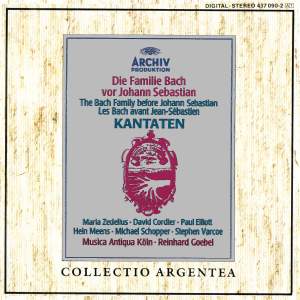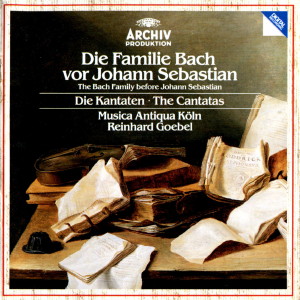 |
|
1 CD -
437 090-2 - (c) 1986
|
 |
| 2 LP's -
419 253-1 - (p) 1986 |
|
| DIE
FAMILIE BACH VOR JOHANN SEBASTIAN |
|
|
|
|
|
Johann Michael Bach
(1648-1694)
|
|
|
| 1. Ach, bleib
bei uns, Herr Jesu Christ |
5' 29" |
|
| Scoring: Chor
(S,A,T,B) - Piccolo-Violine,
Violine I/II, Violoncello,
Violone, Orgel |
|
|
| 2.
Liebster Jesu, hör mein Flehen |
6' 55" |
|
| Scoring:
Solisten - Violine I/II, Viola
I/II, Violoncello, Violone,
Orgel |
|
|
| 3.
Ach, wie sehnlich wart' ich der
Zeit |
7' 20" |
|
| Scoring: Solist
- Violine I/II, Viola I/II,
Violoncello, Violone, Laute,
Orgel |
|
|
|
|
|
| Georg Christoph Bach
(1642-1697) |
|
|
| 4.
Siehe, wie fein und lieblich |
6' 24" |
|
| Scoring:
Solisten - Solo-Violine, Viola
da gamba I-III, Violone, Laute,
Orgel
|
|
|
| 5. Herr, wende
dich und sei mir gnädig |
11' 34" |
|
| Scoring:
Solisten - Violine I/II, Viola
I/II, Violoncello, Violone,
Orgel |
|
|
|
|
|
| Johann Christoph Bach
(1642-1703) |
|
|
| 6.
Meine Freundin, du bist schön |
21' 55" |
|
| Scoring:
Solisten, Chor (S. A. T. B) -
Solo-Violine, Viola I-III,
Violoncello, Violone, Cembalo |
|
|
|
|
|
| Maria Zedelius,
Sopran (2,3,6) |
RHEINISCHE KANTOREI
/ Hermann Max, Chroleiter |
|
| David Cordier,
Altus (2,5,6) |
MUSICA ANTIQUA
KÖLN / Reinhard Goebel,
Leitung
|
|
| Paul Elliott,
Tenor (2,4,5,6) |
- Reinhard Goebel, Violine (solo/I) |
|
| Hein Meens, Tenor
(opran (2,4,4) |
- Mary Utiger, Violine (II)
|
|
| Michael Schopper,
Bass (2,5,6) |
- Hajo Bäß, Violine (I),
Violetta (Viola I)
|
|
| Stephen Varcoe,
Bass (4) |
- Paula Kibildis, Violetta (Viola
II)
|
|
|
- Phoebe Carrai, Violoncello |
|
|
- Christina
Kyprianides, Viola da gamba
(I) |
|
|
- José Vázquez, Viola da gamba
(II) |
|
|
- Loni Patt, Viola da gamba
(III) |
|
|
- Jean-Michel Forest,
Violone |
|
|
- Konrad Junghänel,
Laute |
|
|
- Andreas Staier, Orgel |
|
|
|
|
|
Luogo
e data di registrazione |
|
Immanuelskirche,
Wuppertal (Germania) - gennaio
1986 |
|
|
Registrazione:
live / studio |
|
studio |
|
|
Producer /
Engineer |
|
Andreas
Holschneider / Heinz Wildhagen |
|
|
Prima Edizione
LP |
|
Archiv
- 419 253-1 - (2 lp's) - durata
57' 59" | 52' 10" - (p) 1986 -
Digitale - (parziale)
|
|
|
Edizione
"Collectio" CD |
|
Archiv
- 437 090-2 - (1 cd) - durata 60'
19" - (c) 1986 - DDD |
|
|
Note |
|
Co-Produktion
mit dem WDR Köln.
|
|
|
|
|
CANTATAS
BY THE BACH
FAMILY BEFORE
JOHANN
SEBASTIAN
The
urge to collect, organize
and preserve was obviously a
fundamental trait of Johann
Sebastian Bach’s character.
It was therefore only
natural that an interest in
his family history led him
to collect his forebears’
compositions. The fact that
a respectable number of
those works have survived to
the present day is due very
largely to his concern for
them.
He wrote a brief family
history, Ursprung der
musicalisch-bachischen
Familie (“Origins of
the Bach Family of
Musicians”, Bach-Dokumente
I, 255 ff), which includes a
genealogical outline and
character sketches of
individual members of the
clan. He also compiled an
“Altbachisches Archiv” (an
Archive of past members of
the Bach family) containing
the compositions he had
collected: cantatas, motets
and strophic choral songs.
After his death, the
collection passed to his son
Carl Philipp Emanuel Bach,
though it is not certain
whether it did so in its
entirety. When Carl Philipp
Emanuel died, the “Archive”
was auctioned, together with
the rest of his library, in
Hamburg in 1790.
The “Archive”, along with
all the rest of the music in
Carl Philipp Emanuel’s
estate, was bought by Georg
Poelchau, to add to his
(musico-historically
speaking) invaluable
collection. It then passed
into the hands of Carl
Friedrich Zelter, and from
him into the possession of
the Berliner Singakademie.
On the occasion of the Bach
anniversary in 1935, the
music historian Max
Schneider published the
vocal works making up the
“Archive” in a two-volume
edition, in the series Erbe
Deutscher Musik. It
was in the nick of time, for
the Berliner Singakademie’s
entire collection of
manuscripts was burnt during
the Second World War. Since
then a few more Bach family
manuscripts have been
authenticated, which
supplement Schneider’s
edition.
The present selection was
made from those compositions
which can be termed
“cantatas” or “vocal
concertos”, that is, the
works for solo voices, choir
and concertante instruments.
The rest of the “Archive”
consists of motets and
so-called “arias” (songs for
choir): they are all for
choir and continuo.
The composers and their
works
Four composers are
identified by name in the
“Archive”: J.B.
(= Johannes Bach), Johann
Sebastian’s great-uncle, who
is represented by three
motets with continuo; Georg
Christoph, who was an uncle
of Johann
Sebastian; and two of Georg
Christoph’s cousins, Johann
Christoph and Johann
Michael. Johann
Michael was also Johann
Sebastian’s father-in-law,
as his daughter Maria
Barbara was Johann
Sebastian’s first wife.
Apart from works by these
four, only one other vocal
work by a forebear of Johann
Sebastian has survived: the
vocal concerto “Ich danke
dir, Gott”, by Heinrich
Bach. No other vocal
compositions have survived,
so far as is known, by
members of the generations
of Johann
Sebastian’s parents or
grandparents, or earlier
generations (see the excerpt
from the Bach family tree,
p. 9).
The compositions on this
recording represent various
genres of the cantata as it
was known to J. S.
Bach. They include church
Cantatas for various solo
and choral forces. The texts
are concerned with the
wretchedness of earthly
life, mourning, the sinner’s
contrition, and the praise
and glorification of God. Of
the secular works, one,
“Meine Freundin, du bist schön”,
is an extensive wedding
cantata also suitable for
domestic music-making.
For all the variety of style
and technique exhibited by
these six cantatas, they
have one important thing in
common, and that is the
power of their rhetorical
expression, which is also
shared by the instruments.
The sensitivity in the
interpretation of texts
anticipates the rhetorical
elements in Johann
Sebastian Bach’s musical
language. This is already
true of the strophic
cantatas of Johann Michael
Bach with the heartfelt
emotion of their melodies
which also finds expression
in the instrumental parts;
and it is carried to even
greater artistic heights in
the works of his elder
brother Johann Christoph. He
was certainly the
outstanding composer in the
Bach family before Johann
Sebastian, who used the word
‘profound’ to describe him
in his family history, gave
a performance in Leipzig of
his monumental 22-part
cantata in honour of St.
Michael “Es erhub sich ein
Streit”, and was plainly
influenced by him in his own
Michaelmas cantatas, BWV 19
and 50. In the wedding
cantata, for example, there
is a subtle, frequently
repeated cantilena, “Mein
Freund ist mein und ich bin
sein”, which is accompanied
by a series of impassioned
virtuoso violin solos: fiery
Cupid’s darts aimed at the
bride, in the spirit of the
text, but technically a
sequence of instrumental
variations in the form of a
chaconne. Another example is
to be found in the lament
“Wie bist du denn, O
Gott”, where the violin part
gives a bravura depiction of
the blows God inflicts on
the human heart. These
instrumental accompaniments
amount to much more than
wordpainting, however: even
in the polyphonic textures
of the inner parts, they
represent part-writing of
very high quality and
individuality.
Andreas
Holschneider
(Translation:
Mary
Whittall)
|
|